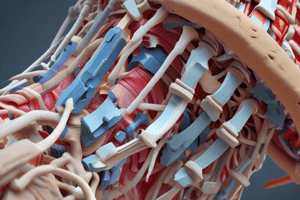Podcast
Questions and Answers
Shear force in the lumbar spine is resisted solely by the disks.
Shear force in the lumbar spine is resisted solely by the disks.
False (B)
The ranges of elementary movements in the spine are significant because of the large individual movements at each level.
The ranges of elementary movements in the spine are significant because of the large individual movements at each level.
False (B)
During flexion, the upper vertebra moves backward and the intervertebral disc thickens anteriorly.
During flexion, the upper vertebra moves backward and the intervertebral disc thickens anteriorly.
False (B)
Flexion transfers load from the intervertebral discs to the apophyseal joints.
Flexion transfers load from the intervertebral discs to the apophyseal joints.
During flexion, the inferior articular processes of the upper vertebra glide downwards.
During flexion, the inferior articular processes of the upper vertebra glide downwards.
Lateral flexion compresses and bulges the posterior side of the annulus fibrosus.
Lateral flexion compresses and bulges the posterior side of the annulus fibrosus.
The ligamentum flavum is not maximally stretched during flexion.
The ligamentum flavum is not maximally stretched during flexion.
The posterior longitudinal ligament does not limit flexion in the spine.
The posterior longitudinal ligament does not limit flexion in the spine.
Rotation combined with flexion poses the greatest risk of injury due to compressive and flexion forces.
Rotation combined with flexion poses the greatest risk of injury due to compressive and flexion forces.
The alar ligament limits axial rotation in the lumbar region.
The alar ligament limits axial rotation in the lumbar region.
The interspinous and supraspinous ligaments restrict flexion movements.
The interspinous and supraspinous ligaments restrict flexion movements.
The anterior annulus fibrosus is involved in limiting lateral flexion.
The anterior annulus fibrosus is involved in limiting lateral flexion.
The contralateral capsule of the apophyseal joints restricts lateral flexion.
The contralateral capsule of the apophyseal joints restricts lateral flexion.
The ligamentum nuchae plays a role in limiting axial rotation.
The ligamentum nuchae plays a role in limiting axial rotation.
The posterior longitudinal ligament restricts extension movements.
The posterior longitudinal ligament restricts extension movements.
The capsule of the apophyseal joints limits lateral flexion in the lumbar region.
The capsule of the apophyseal joints limits lateral flexion in the lumbar region.
During extension, the disc becomes thicker posteriorly and flatter anteriorly.
During extension, the disc becomes thicker posteriorly and flatter anteriorly.
During extension, the nucleus is pushed posteriorly towards the neural tissue.
During extension, the nucleus is pushed posteriorly towards the neural tissue.
Lateral flexion causes the upper vertebra to be raised on the concave side.
Lateral flexion causes the upper vertebra to be raised on the concave side.
During lateral flexion, the contralateral intertransverse ligament is slackened.
During lateral flexion, the contralateral intertransverse ligament is slackened.
Extension transfers load from the intervertebral discs to the vertebral bodies.
Extension transfers load from the intervertebral discs to the vertebral bodies.
During lateral flexion, the articular processes of the upper and lower vertebrae glide apart.
During lateral flexion, the articular processes of the upper and lower vertebrae glide apart.
In extension, the posterior longitudinal ligament is tense and stretched.
In extension, the posterior longitudinal ligament is tense and stretched.
Lateral flexion causes the disc to become thicker on the same side of flexion.
Lateral flexion causes the disc to become thicker on the same side of flexion.
Flashcards are hidden until you start studying




